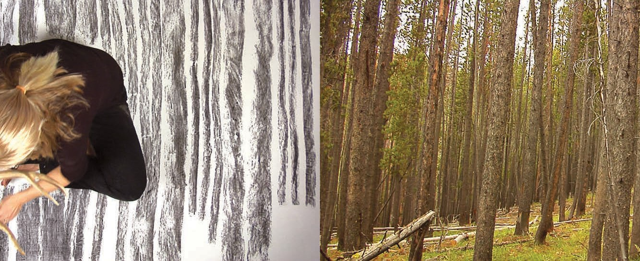Editorial, Issue 1
NOTE FROM THE EDITOR
I was organizing my notes last night in preparation to write an exhibition review of the Currier Museum’s summer video installation show Shifting Terrain: Landscape Video. I knew that the show fit in quite well with the theme of Gnome Magazine’s first issue, Technology and the Body, but I had no idea just how close the connections were until I had all of my material spread out before me: stickie-notes, self-sent text messages, press releases, catalogues, reviews, phone images and videos, all reminders of my experience at the Currier. Previously, I held the belief that the show was about modernity’s effect on the land, but as I looked at the landscape of notes and piles of information on my dining room table, my interpretation shifted to a focus that was more about the individual in the face of a changing landscape; one who feels the pressure to document and collect in the delete-after-one-month world in which we live. My thoughts circled around ideas of time, history and identity. Oh,how fast everything changes! I thought of the popularity of the video medium, both within the walls of the art institution and out. I questioned the show’s intention of addressing landscape primarily through video. What does it mean to position the moving image as the ideal way to represent nature and our relationship to it?
Both the writers in this inaugural issue and the artists in Shifting Terrain present us with the pros and cons of technology, the most significant being its function as a tool for documentation and communication, and its position as a physical entity that pressures our physical land, bodies, minds and relationships. Brittany Bailey, for example, in her thoughtful and honest recollection of her time spent with performance artist Marina Abromovic, modestly describes the complicated and over-saturated world of perception and physical influence. She comes to terms with technology by forcing herself to become aware of the moments of reflective time in which her body is intentionally removed from the chaos of the external world. JD Ho, in another first-person account, humorously details her struggles with the acceptance of new media as a necessary tool for creative sharing and engagement in critical discourse. Stuart Kurtz and Vincent Scarpa speak about technology’s position as a system of communication. Kurtz suggests that technology “strips the genuine out of human relationships,” but emphasizes, in likeness of the director that he writes about, that it must not be demonized, for there is no escaping it.
When I think of technology as a system of communication, it is difficult to not think of our current tools: Skype, Smart phones, Facechat, etc. The popularity of such tools, and technology in general, is a conversation that is already in existence and not one that we claim ownership to. What we are offering then, with Gnome Magazine, is a continuation of those conversations, a new platform for discussion. Through a number of writing styles, including interviews, exhibition reviews, featured articles and columns, writers and artists alike are given the chance to showcase their knowledge and opinions of our current world. We encourage our readers to think about their own lives in relation to some of the ideas proposed by Gnome and to share them with us to help in the continuation of a dialogue that will hopefully continue outside the pages of this magazine.
— Kimberly Ruth
(above) Dead Standing and Selva Oscura: Drawing of Dead Standing , Mary Ellen Strom, 2011 (from Shifting Terrain: Landscape Video)
Two-channel video installation, 10:22 minute cycle.
Photo courtesy of the Artist and Alexander Gray Associates, New York City.




